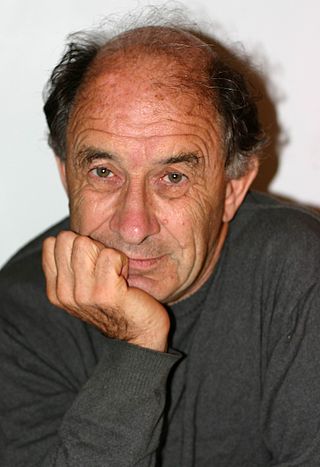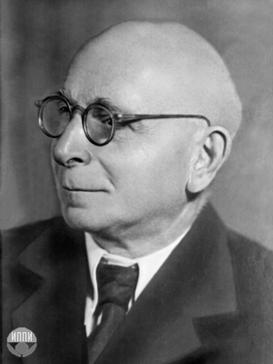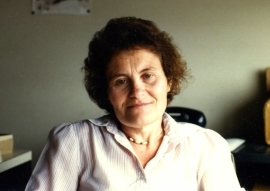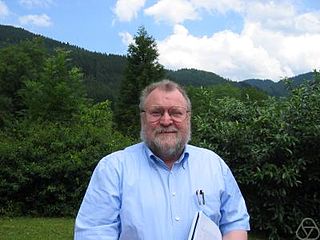Related Research Articles
The Kolmogorov–Arnold–Moser (KAM) theorem is a result in dynamical systems about the persistence of quasiperiodic motions under small perturbations. The theorem partly resolves the small-divisor problem that arises in the perturbation theory of classical mechanics.

Vladimir Igorevich Arnold was a Soviet and Russian mathematician. He is best known for the Kolmogorov–Arnold–Moser theorem regarding the stability of integrable systems, and contributed to several areas, including geometrical theory of dynamical systems theory, algebra, catastrophe theory, topology, real algebraic geometry, symplectic geometry, symplectic topology, differential equations, classical mechanics, differential geometric approach to hydrodynamics, geometric analysis and singularity theory, including posing the ADE classification problem.

Andrey Nikolaevich Kolmogorov was a Soviet mathematician who contributed to the mathematics of probability theory, topology, intuitionistic logic, turbulence, classical mechanics, algorithmic information theory and computational complexity.

Carl Ludwig Siegel was a German mathematician specialising in analytic number theory. He is known for, amongst other things, his contributions to the Thue–Siegel–Roth theorem in Diophantine approximation, Siegel's method, Siegel's lemma and the Siegel mass formula for quadratic forms. He has been named one of the most important mathematicians of the 20th century.

Sergei Natanovich Bernstein was a Ukrainian and Russian mathematician of Jewish origin known for contributions to partial differential equations, differential geometry, probability theory, and approximation theory.
Jürgen Kurt Moser was a German-American mathematician, honored for work spanning over four decades, including Hamiltonian dynamical systems and partial differential equations.

Marina Evseevna Ratner was a professor of mathematics at the University of California, Berkeley who worked in ergodic theory. Around 1990, she proved a group of major theorems concerning unipotent flows on homogeneous spaces, known as Ratner's theorems. Ratner was elected to the American Academy of Arts and Sciences in 1992, awarded the Ostrowski Prize in 1993 and elected to the National Academy of Sciences the same year. In 1994, she was awarded the John J. Carty Award from the National Academy of Sciences.
The Nekhoroshev estimates are an important result in the theory of Hamiltonian systems concerning the long-time stability of solutions of integrable systems under a small perturbation of the Hamiltonian. The first paper on the subject was written by Nikolay Nekhoroshev in 1971.

Eduard J. Zehnder is a Swiss mathematician, considered one of the founders of symplectic topology.

Raphael Douady is a French mathematician and economist. He holds the Robert Frey Endowed Chair for Quantitative Finance at Stony Brook, New York. He is a fellow of the Centre d’Economie de la Sorbonne, Paris 1 Pantheon-Sorbonne University, and academic director of the Laboratory of Excellence on Financial Regulation.
In real analysis and approximation theory, the Kolmogorov–Arnold representation theorem states that every multivariate continuous function can be represented as a superposition of the two-argument addition of continuous functions of one variable. It solved a more constrained form of Hilbert's thirteenth problem, so the original Hilbert's thirteenth problem is a corollary.
Julia Chuzhoy is an Israeli mathematician and computer scientist at the Toyota Technological Institute at Chicago, known for her research on approximation algorithms and graph theory.
Vladimir Mikhailovich Alekseev was a Russian mathematician who specialized in celestial mechanics and dynamical systems.
Alessandra Celletti is an Italian mathematician. She earned a master's degree in mathematics in 1984 at the University of Rome La Sapienza, and a PhD in 1989 at the Swiss Federal Institute of Technology in Zurich (ETH) under the supervision of Jürgen Moser and Jörg Waldvogel. Her research activity concerns dynamical systems, Kolmogorov–Arnold–Moser (KAM) theory, and celestial mechanics.

Sergei Borisovich Kuksin is a French and Russian mathematician, specializing in partial differential equations (PDEs).
Luigi Chierchia is an Italian mathematician, specializing in nonlinear differential equations, mathematical physics, and dynamical systems.
Poincaré and the Three-Body Problem is a monograph in the history of mathematics on the work of Henri Poincaré on the three-body problem in celestial mechanics. It was written by June Barrow-Green, as a revision of her 1993 doctoral dissertation, and published in 1997 by the American Mathematical Society and London Mathematical Society as Volume 11 in their shared History of Mathematics series (ISBN 0-8218-0367-0). The Basic Library List Committee of the Mathematical Association of America has suggested its inclusion in undergraduate mathematics libraries.
SergeiViktorovich Bochkarev is a Soviet and Russian mathematician.
References
- ↑ Dumas, H. Scott (2014), The KAM story: A friendly introduction to the content, history, and significance of classical Kolmogorov–Arnold–Moser theory, Hackensack, NJ: World Scientific, p. 154, doi:10.1142/8955, ISBN 978-981-4556-58-3, MR 3222196
- ↑ Khesin, Boris (October 24, 2011), Colliander, James (ed.), "Addendum to Arnold Memorial Workshop: Khesin on Pinzari's talk", James Colliander's Blog, archived from the original on March 29, 2017, retrieved March 29, 2017
- 1 2 3 homepage, archived from the original on 2018-11-07, retrieved 2019-05-27
- ↑ Gabriella Pinzari at the Mathematics Genealogy Project
- ↑ "ICM Plenary and Invited Speakers since 1897", International Mathematical Union (IMU), archived from the original on 2017-11-08, retrieved 2017-03-28